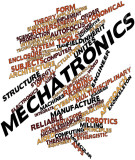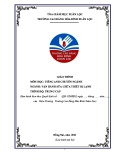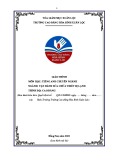
Trêng ®¹i häc kü thuËt c«ng nghiÖp
Khoa khoa häc c¬ b¶n
Bé m«n: Ngo¹i ng÷
ng©n hµng c©u hái thi kÕt thóc häc phÇn
häc phÇn: tiÕng anh kü thuËt
(3 tÝn chØ)
Dïng cho ®µo t¹o bËc ®¹i häc theo häc chÕ tÝn chØ
c¸c ngµnh ®iÖn vµ ®iÖn tö
Th¸i nguyªn – 8/2007

1. N I DUNG ĐÁNH GIÁ THI K T THÚC H C PH NỘ Ế Ọ Ầ
UNIT 1: Conductors, insulators and semiconductors
Reading:
- True or False
- Rephrasing
- Contextual reference
- Summarizing
Use of language:
- Description of shapes, positions and connections, experiments
- Relative clauses
- Passive voice
Writing:
- Writing instructions
- Sentence / Paragraph building
UNIT 2: Circuit elements
Reading:
- True or False
- Rephrasing
- Contextual reference
- Summarizing
Use of language:
- Description of function, purpose
- Relative clauses
Writing:
- Sentence / Paragraph building
UNIT 3: The dc motor
Reading:
- Contextual reference
- Note-taking
Use of language:
- Description of positions, components
- Relative clauses
- Comparison and contrast
Writing:
- Sentence building
- Writing impersonal instructions
UNIT 4: The cathode ray tube
Reading:
- Contextual reference

- Note-taking
Use of language:
- Description of a process, sequence, distribution of power
- Short relative clauses
UNIT 5: Process control systems
Reading:
- Contextual reference
- Reading for specific information
- Note-taking
Use of language:
- Cause and Effect
Writing:
- Sentence building
UNIT 6: Logic gates
Reading:
- Finding out facts
- Summarizing
Use of language:
- Making predictions
Writing:
- Grouping sentences
2. PH NG PHÁP ĐÁNH GIÁƯƠ
- T lu nự ậ
- Hình th c thi vi t (th i gian:90’)ứ ế ờ
3. NGUYÊN T C T H P CÂU H I Đ LÀM Đ THI K T THÚC H C PH NẮ Ổ Ợ Ỏ Ể Ề Ế Ọ Ầ
-Nguyên t c: ắ
+ K t h p gi a các ph n câu h iế ợ ữ ầ ỏ
+ M t đ thi bao g m 4 lo i câu h i: 6 câu lo i 1, 4 câu lo i 2, 6 câu lo i 3, 5ộ ề ồ ạ ỏ ạ ạ ạ
câu lo i 4.ạ
+ Câu h i lo i 3 đ c t h p t các lo i 3a, 3b, 3c; m i lo i 2 câuỏ ạ ượ ổ ợ ừ ạ ỗ ạ
-Thang đi m:ể
+ Câu h i lo i 1: 3 đi m (6 câu h i đ c hi u, m i câu 0,5đi m)ỏ ạ ể ỏ ọ ể ỗ ể
+ Câu h i lo i 2: 0,25 đi m ỏ ạ ể
+ Câu h i lo i 3: 0,5 đi mỏ ạ ể
+ Câu h i lo i 4: 0,5 đi mỏ ạ ể
-Lo i câu h iạ ỏ :
+ Câu h i lo i 1: Read the following passage and answer the questions below.ỏ ạ
+ Câu h i lo i 2: Choose the best word to fill in the gaps. ỏ ạ
+ Câu h i lo i 3: Rewrite the following sentences without changing the meanings.ỏ ạ
+ Câu h i lo i 4: Give the correct form of the word in brackets.ỏ ạ

4. NGÂN HÀNG CÂU H I Ỏ
4.1.Câu h i lo i 1ỏ ạ
1. ELECTRIC MOTOR
An electric motor converts electrical energy into mechanical energy. The reverse process, that
of converting mechanical energy into electrical energy, is accomplished by a generator or
dynamo. Traction motors used on locomotives often perform both tasks if the locomotive is
equipped with dynamic brakes. Electric motors are found in household appliances such as
fans, refrigerators, washing machines, pool pumps and fan-forced ovens.
Most electric motors work by electromagnetism, but motors based on other electromechanical
phenomena, such as electrostatic forces and the piezoelectric effect, also exist. The
fundamental principle upon which electromagnetic motors are based is that there is a
mechanical force on any current-carrying wire contained within a magnetic field. The force is
described by the Lorentz force law and is perpendicular to both the wire and the magnetic
field. Most magnetic motors are rotary, but linear motors also exist. In a rotary motor, the
rotating part (usually on the inside) is called the rotor, and the stationary part is called the
stator. The rotor rotates because the wires and magnetic field are arranged so that a torque is
developed about the rotor's axis. The motor contains electromagnets that are wound on a
frame. Though this frame is often called the armature, that term is often erroneously applied.
Correctly, the armature is that part of the motor across which the input voltage is supplied.
Depending upon the design of the machine, either the rotor or the stator can serve as the
armature.
Questions:
1. What is the function of an electric motor?
2. Where are electric motors found?
3. What is the fundamental principle upon which electromagnetic motors are based?
4. How is the force described by Lorentz force law?
5. What is the rotating part called and what is the stationary part called?
6. Is the armature the rotor or the stator?
2. Stepper motors
Closely related in design to three-phase AC synchronous motors are stepper motors, where an
internal rotor containing permanent magnets or a large iron core with salient poles is
controlled by a set of external magnets that are switched electronically. A stepper motor may
also be thought of as a cross between a DC electric motor and a solenoid. As each coil is
energized in turn, the rotor aligns itself with the magnetic field produced by the energized field
winding. Unlike a synchronous motor, in its application, the motor may not rotate
continuously; instead, it "steps" from one position to the next as field windings are energized
and de-energized in sequence. Depending on the sequence, the rotor may turn forwards or
backwards.
Simple stepper motor drivers entirely energize or entirely de-energize the field windings,
leading the rotor to "cog" to a limited number of positions; more sophisticated drivers can
proportionally control the power to the field windings, allowing the rotors to position
"between" the "cog" points and thereby rotate extremely smoothly. Computer controlled

stepper motors are one of the most versatile forms of positioning systems, particularly when
part of a digital servo-controlled system.
Stepper motors can be rotated to a specific angle with ease, and hence stepper motors are used
in pre-gigabyte era computer disk drives, where the precision they offered was adequate for
the correct positioning of the read/write head of a hard disk drive. As drive density increased,
the precision limitations of stepper motors made them obsolete for hard drives, thus newer
hard disk drives use read/write head control systems based on voice coils.
Questions:
1. To what are stepper motors closely related in design?
2. Why does the rotor align itself with the magnetic field produced by the energized field
winding?
3. Does the motor rotate continuously?
4. What are one of the most versatile forms of positioning systems?
5. Where are stepper motors are used?
6. What are the read/write head control systems of newer hard disk drives based on?
3. Dynamo
The Dynamo was the first electrical generator capable of delivering power for industry. The
dynamo uses electromagnetic principles to convert mechanical rotation into an alternating
electric current. A dynamo machine consists of a stationary structure which generates a strong
magnetic field, and a set of rotating windings which turn within that field. On small machines
the magnetic field may be provided by a permanent magnet; larger machines have the
magnetic field created by electromagnets.
The first dynamo based on Faraday's principles was built in 1832 by Hippolyte Pixii, a French
instrument maker. It used a permanent magnet which was rotated by a crank. The spinning
magnet was positioned so that its north and south poles passed by a piece of iron wrapped with
wire. Pixii found that the spinning magnet produced a pulse of current in the wire each time a
pole passed the coil. Furthermore, the north and south poles of the magnet induced currents in
opposite directions. By adding a commutator, Pixii was able to convert the alternating current
to direct current.
Unlike the Faraday disc, many turns of wire connected in series can be used in the moving
windings of a dynamo. This allows the terminal voltage of the machine to be higher than a
disc can produce, so that electrical energy can be delivered at a convenient voltage.
The relationship between mechanical rotation and electric current in a dynamo is reversible;
the principles of the electric motor were discovered when it was found that one dynamo could
cause a second interconnected dynamo to rotate if current was fed through it.
Questions:
1. What was the first electrical generator capable of delivering power for industry?
2. What does a dynamo machine consist of?
3. When was the first dynamo based on Faraday's principles built?
4. What provides the magnetic field on small machines?

![Bài giảng Anh văn chuyên ngành Điện - Điện tử [mới nhất]](https://cdn.tailieu.vn/images/document/thumbnail/2025/20250806/vijiraiya/135x160/84061754472437.jpg)










![Tài liệu Từ vựng tiếng Anh Trung cấp [mới nhất]](https://cdn.tailieu.vn/images/document/thumbnail/2025/20250913/nguyentuan250421@gmail.com/135x160/99491757910839.jpg)
![Tài liệu Từ vựng Tiếng Anh theo chủ đề [mới nhất]](https://cdn.tailieu.vn/images/document/thumbnail/2025/20250913/namdhuet@gmail.com/135x160/83251757753810.jpg)



![Tài liệu Từ vựng tiếng Anh cho bé [chuẩn nhất/mới nhất]](https://cdn.tailieu.vn/images/document/thumbnail/2025/20250731/huadaithesang2509@gmail.com/135x160/18631754013896.jpg)








